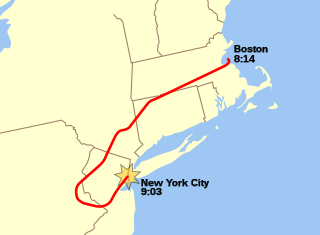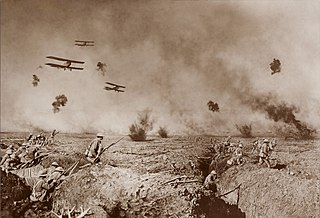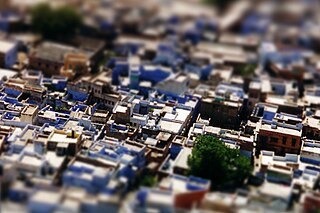
United Airlines Flight 175 was a domestic passenger flight from Logan International Airport in Boston to Los Angeles International Airport in California that was hijacked by five al-Qaeda terrorists on the morning of September 11, 2001, as part of the September 11 attacks. The aircraft involved, a Boeing 767-200 carrying 65 passengers and crew, was deliberately crashed into the South Tower of the World Trade Center in New York City, killing everyone aboard and causing the deaths of more than 600 people in the South Tower's upper levels in addition to an unknown number of civilians and emergency personnel on floors beneath the impact zone. Flight 175's hijacking not only led to it being the second-deadliest of the four suicide attacks carried out on the day in terms of plane and ground fatalities, but also secured its place as second-deadliest plane crash in aviation history, surpassed only by American Airlines Flight 11.
The September 11 attacks of 2001, in addition to being a unique act of terrorism, constituted a media event on a scale not seen since the advent of civilian global satellite links. Instant worldwide reaction and debate were made possible by round-the-clock television news organizations and by the internet. As a result, most of the events listed below were known by a large portion of the world's population as they occurred.

9/11 is a 2002 documentary film about the September 11 attacks in New York City, in which two planes were flown into the buildings of the World Trade Center, resulting in their destruction and the deaths of nearly 3,000 people. The film is from the point of view of the New York City Fire Department. The film was directed by brothers Jules and Gédéon Naudet and FDNY firefighter James Hanlon and produced by Susan Zirinsky of CBS News.

Aerial photography is the taking of photographs from an aircraft or other airborne platforms. When taking motion pictures, it is also known as aerial videography.

Photojournalism is journalism that uses images to tell a news story. It usually only refers to still images, but can also refer to video used in broadcast journalism. Photojournalism is distinguished from other close branches of photography by having a rigid ethical framework which demands an honest and impartial approach that tells a story in strictly journalistic terms. Photojournalists contribute to the news media, and help communities connect with one other. They must be well-informed and knowledgeable, and are able to deliver news in a creative manner that is both informative and entertaining.

Photograph manipulation involves the transformation or alteration of a photograph. Some photograph manipulations are considered to be skillful artwork, while others are considered to be unethical practices, especially when used to deceive. Photographs may be manipulated for political propaganda, to improve the appearance of a subject, for entertainment, or as humor.

Aerial survey is a method of collecting geomatics or other imagery by using airplanes, helicopters, UAVs, balloons or other aerial methods. Typical types of data collected include aerial photography, Lidar, remote sensing and also geophysical data (such as aeromagnetic surveys and gravity. It can also refer to the chart or map made by analysing a region from the air. Aerial survey should be distinguished from satellite imagery technologies because of its better resolution, quality and atmospheric conditions. Today, aerial survey is sometimes recognized as a synonym for aerophotogrammetry, part of photogrammetry where the camera is placed in the air. Measurements on aerial images are provided by photogrammetric technologies and methods.

Geotagging, or GeoTagging, is the process of adding geographical identification metadata to various media such as a geotagged photograph or video, websites, SMS messages, QR Codes or RSS feeds and is a form of geospatial metadata. This data usually consists of latitude and longitude coordinates, though they can also include altitude, bearing, distance, accuracy data, and place names, and perhaps a time stamp.

Thoughtography, also called projected thermography,psychic photography,nengraphy, and nensha(Japanese: 念写), is the claimed ability to "burn" images from one's mind onto surfaces such as photographic film by parapsychic means. While the term "thoughtography" has been in the English lexicon since 1913, the more recent term "projected thermography" is a neologism popularized in the 2002 American film The Ring, a remake of the 1998 Japanese horror film Ring.

Digital photography uses cameras containing arrays of electronic photodetectors interfaced to an analog-to-digital converter (ADC) to produce images focused by a lens, as opposed to an exposure on photographic film. The digitized image is stored as a computer file ready for further digital processing, viewing, electronic publishing, or digital printing. It is a form of digital imaging based on gathering visible light.

Spirit photography is a type of photography whose primary goal is to capture images of ghosts and other spiritual entities, especially in ghost hunting. It dates back to the late 19th century. The end of the American Civil War and the mid-19th Century Spiritualism movement contributed greatly to the popularity of spirit photography. Photographers such as William Mumler and William Hope ran thriving businesses taking photos of people with their supposed dead relatives. Both were shown to be frauds, but "true believers", such as Sir Arthur Conan Doyle, refused to accept the evidence as proof of a hoax.

The Falling Man is a photograph taken by Associated Press photographer Richard Drew of a man falling from the World Trade Center during the September 11 attacks in New York City. The unidentified man in the image was trapped on the upper floors of the North Tower, and it is unclear whether he fell while searching for safety or he jumped to escape the fire and smoke. The photograph was taken at 9:41:15 A.M.
The 2006 Lebanon War photographs controversies refers to instances of photojournalism from the 2006 Lebanon War that misrepresented scenes of death and destruction in Lebanon caused by Israeli air attacks.

Miniature faking, also known as diorama effect or diorama illusion, is a process in which a photograph of a life-size location or object is made to look like a photograph of a miniature scale model. Blurring parts of the photo simulates the shallow depth of field normally encountered in close-up photography, making the scene seem much smaller than it actually is; the blurring can be done either optically when the photograph is taken, or by digital postprocessing. Many diorama effect photographs are taken from a high angle to simulate the effect of looking down on a miniature. Tilt–shift photography is also associated with miniature faking.
Monty the meerkat is a meerkat that made headlines in the British media in September 2007 for his purported ability to take pictures using a digital camera. The story turned out to be a hoax perpetrated by workers at Longleat Safari Park.

Impending Death is a photograph taken by freelance photographer Thomas Dallal during the September 11 attacks. The photograph depicts the North Tower of the World Trade Center, on fire after being struck by American Airlines Flight 11 at 8:46 a.m., and shortly before its collapse at 10:28 a.m. Visible in the photograph are numerous people trapped in the upper floors of the building, hanging out of windows because of the intense smoke and heat. They were unable to escape because all of the stairwells and elevators above the 91st floor were severed by Flight 11's impact.
During the September 11 attacks of 2001, a series of four coordinated terrorist attacks by the Islamic terrorist group al-Qaeda, killed 2,977 people, injured over 6,000, and caused at least $10 billion in infrastructure and property damage. Multiple others have died due to 9/11-related cancer and respiratory diseases in the months and years following the attacks, leading the numbers impacted to continually shift to reflect the new numbers.

View from Williamsburg, Brooklyn, on Manhattan, 9/11 is a color photograph by German photographer Thomas Hoepker. It shows five people sitting on the banks of the East River in the Williamsburg neighborhood of the New York City Borough of Brooklyn while a cloud of smoke rises over Manhattan in the background. It emanates from the collapsed towers of the World Trade Center, which had been the target of a terrorist attack that day.














